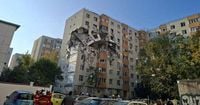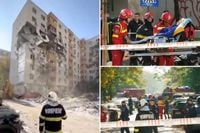On the morning of October 17, 2025, a powerful explosion shattered the calm of Bucharest’s Sector 5, tearing through the fifth and sixth floors of an eight-story apartment building on Calea Rahovei. The blast, which authorities later confirmed was a gas explosion, killed three people and left at least 14 others injured, many suffering from trauma and burns. The devastation was immediate and severe, with the facades of corner apartments mangled and windows blown out in neighboring units.
According to Xinhua, rescue teams discovered the third confirmed fatality as they combed through the rubble. The Department for Emergency Situations (DSU) quickly mobilized, with Raed Arafat, the head of the DSU, stating, “Rescue teams have found another victim, but we have no further details yet.” This grim announcement underscored the chaos and uncertainty in the aftermath of the explosion.
Emergency responders moved swiftly, deploying more than a dozen vehicles to the scene, including 11 fire engines and four mobile intensive care units, as reported by the Associated Press. The Red Intervention Plan—a coordinated emergency response protocol—was activated to ensure that every available resource was brought to bear. Firefighters, medics, and search teams, including two canine units, converged on the site, searching for survivors and assessing the structural integrity of the building.
The explosion’s impact was not limited to the apartment block itself. The force of the blast blew out windows at a nearby high school, prompting authorities to evacuate both pupils and teachers as a precaution. The General Inspectorate for Emergency Situations confirmed that the evacuation was carried out swiftly to ensure the safety of those in the vicinity. As debris rained down and the air filled with dust and the acrid smell of burned material, a RO-ALERT message was broadcast, urging residents to avoid the area and follow official guidance.
Video footage shared by emergency authorities and described by the Associated Press showed the extent of the destruction: facades torn open, rubble strewn across the street, and emergency workers carrying the injured away on stretchers. The blast’s shockwave detached construction elements from the building’s exterior, affecting another nearby apartment block and leaving the street below littered with debris.
As the day unfolded, the health ministry established a crisis cell to coordinate with the DSU, the interior ministry, and emergency hospitals. The focus was on assessing available intensive care beds and reallocating medical resources to treat the injured. The ministry’s rapid response was crucial, given the number and severity of injuries, many of which involved burns and other forms of trauma.
According to Reuters, the explosion completely collapsed two floors of the building, affecting apartments below and raising fears of further collapse. Firefighters ordered the evacuation of all 108 apartments in the block, a move echoed across local media outlets. Teams continued searching the blast site for others who might be trapped, their efforts complicated by the instability of the remaining structure.
The cause of the explosion was not immediately clear, and as of October 17, 2025, authorities had launched a formal investigation. However, details began to emerge about the events leading up to the disaster. News website Biziday reported that the gas supply to the building had been stopped the day before, on October 16, after residents reported smelling gas. This precaution, however, proved tragically insufficient to prevent the calamity.
In the hours after the blast, the gas supply in the area was shut off as a further safety measure, according to the Associated Press. Emergency officials emphasized the importance of this step, hoping to prevent any secondary explosions as rescue and recovery operations continued.
The apartment block on Calea Rahovei is home to a diverse community, and the human toll of the disaster quickly became apparent. Families gathered outside the cordoned-off area, anxiously awaiting news of loved ones. Some residents, their faces streaked with soot and shock, recounted the moment the explosion struck—the sudden roar, the violent shaking of the building, and the frantic scramble to escape. Others sat on the curb, wrapped in blankets, their belongings lost or buried beneath the rubble.
Local media, including Hotnews.ro, reported that the explosion’s shockwave was so powerful that it broke windows in the nearby high school, amplifying concerns about the safety of buildings in the vicinity. Emergency authorities confirmed that, in addition to the main block, another nearby apartment building was affected by detached construction elements, underscoring the blast’s reach and intensity.
As the dust settled, the focus shifted to the investigation. Authorities from the General Inspectorate for Emergency Situations and the local police began the painstaking task of determining what went wrong. The fact that the gas supply had already been stopped following reports of a leak raised questions about the safety protocols in place and whether more could have been done to avert the disaster. For now, officials are keeping all possibilities open, with structural engineers, gas company representatives, and forensic experts combing through the evidence.
The response from Bucharest’s emergency services has been widely praised. The rapid deployment of resources, the activation of the Red Intervention Plan, and the coordination between various agencies helped prevent an even greater tragedy. Still, for those who lost family members or suffered injuries, praise offers little comfort. The city’s residents are left grappling with grief, anger, and uncertainty as they await answers.
In the broader context, the explosion has reignited concerns about building safety and gas infrastructure in Romania’s capital. While gas leaks and explosions are relatively rare, when they do occur, they can be catastrophic. The events on Calea Rahovei serve as a stark reminder of the importance of rigorous safety checks, timely maintenance, and clear communication between residents and utility providers.
For now, the community on Calea Rahovei faces a long road to recovery. Emergency shelters have been set up for displaced residents, and the city has pledged support for those affected. As the investigation continues and the cleanup begins, the hope is that lessons learned from this tragedy will help prevent future disasters.
In the wake of this devastating explosion, Bucharest mourns the loss of life and confronts the urgent task of rebuilding both its damaged structures and the sense of security shaken by the events of October 17, 2025.

